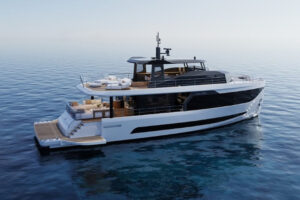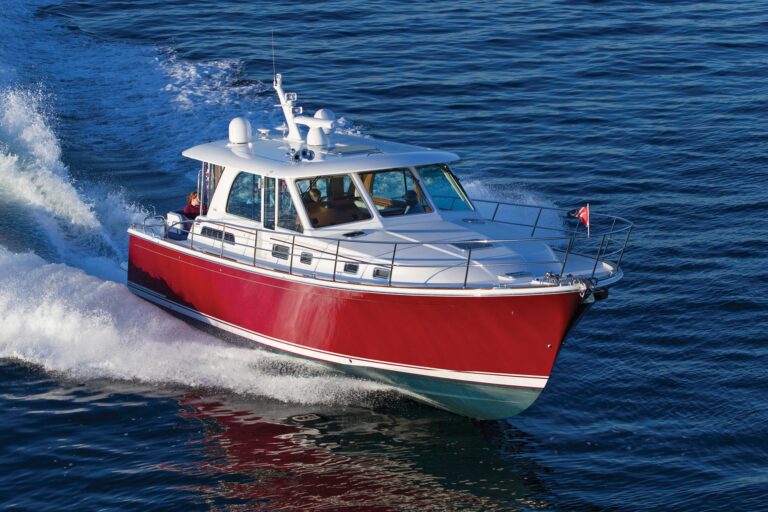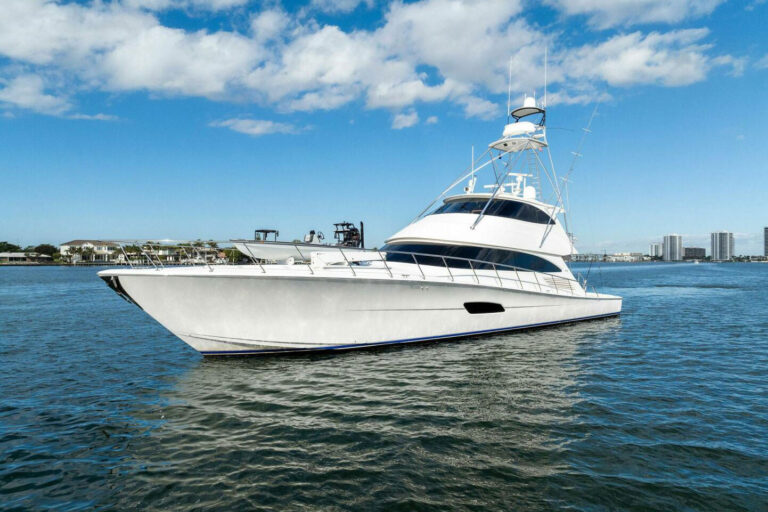The Hargrave 45 open sportfisherman headed east from Port Everglades into the nasty 10- to 12-foot seas off Ft. Lauderdale. No one else our size was venturing out that day, but my philosophy about sea trials, within reason, is, you won’t know if you don’t try.
Often, the worst weather is the best for sea trials, yielding information that can’t be gathered any other way. This day afforded a rare opportunity to experience a boat near the assumed edge of her capability, though fortunately we never found the other side of that line. Most important for this and many pleasure boats is the ability to go from point A to point B safely and comfortably, in real world conditions, as quickly and efficiently as possible. With welded longitudinal framing and plating that meet ABS and USCG commercial standards, the Hargrave 45 is more worthy of the “battlewagon appellation than some of the larger sportfishermen I’ve tested.
That day, she proved tough as a tank.
Running at planing speed to keep her nose up, we frequently had three-quarters of the boat out of the water as we rose above the wave crests before dropping into the menacing troughs. The props and rudders never lost their bite, and there was no slamming or pounding, just a smooth re-entry that was rather tame considering the conditions. The boat slowed a bit climbing each wave but did not struggle, the 1.5:1 gear reduction seeming just about right for her size, weight and power.
There was ample reserve buoyancy in the flare and rake of the bow to keep the deck free of green water. Thanks to wide rails at the chine forward, there was less spray than I expected, though the occasional sheet full in the face was sufficient reminder this was an open boat. We were also running without the windshield, which was off for modifications.
“If you want to ride in the tower, you can probably stay dry from the knees up”, Hargrave President Mike Joyce said with a smile.
I declined the offer, though the dry, spacious cabin was a temptation.
The Hargrave 45, known inside the company as design number 4531, springs from bloodlines that date back to 1975, when I designed my first solo project under Jack Hargrave’s watchful eye: design number 4521, a fiberglass 45-foot fisherman. An even earlier boat, the Daytona 45, designed by Hargrave and numbered 4501, was a traditional wood sportfisherman built by Bob Sherbert for legendary fisherman and yachtsman Charlie Johnson in 1962.
Two years later, Johnson, Sherbert and Hargrave teamed up on a slightly shorter open fisherman based on the lines of the Daytona 45 and put four turbocharged Daytona gasoline engines in her for 50 knot-plus speeds. Johnson christened her TX-41 and with her took home the Miami-New York speed trophy a few months later. TX-41’s record stood for an amazing 10 years while Sherbert continued to build twin-engine versions of the design.
Like TX-41, the new Hargrave 45 is available in open and traditional sportfishing models. Custom-built in aluminum by a Gulf Coast contract yard, our test boat was an open model powered by Caterpillar 3406E diesels. Though the heavy weather prevented measured speed runs outside and security restrictions kept us at low speed inside the inlet, earlier testing by Caterpillar and others indicated a top speed of just over 30 knots with the 800 hp engines turning near their rated 2300 rpm.
Our open version has a single stateroom forward with an island queen berth, two hanging lockers and a head that can be accessed by a second door from the saloon. A dinette to starboard converts to upper-and-lower berths. To port is a sizable U-shape galley. All cabinetry is cherry with a high-gloss finish, polyurethane as standard, upgraded to polyester on our boat. Appliances are top-grade, including Thermador, Sub-Zero and Jenn-Air.
The traditional version of the boat moves the saloon and galley up to the main deck, adding in the vacated space a second head and a second stateroom with upper-and-lower berths.
In addition to the Caterpillars, an impressive collection of equipment is arranged to leave room for maintenance at the business end of the boat. Incoming air passes through Delta-T water-trapped filters to keep salt intrusion to a minimum. Shorepower is routed through an isolation transformer for safety. A galvanic isolator guards against corrosion, always a concern but especially so on an aluminum boat.
Water intakes for various pieces of equipment are centralized on sea chests, with a separate ball valve for each intake. There is a built-in waste oil tank with enough capacity for a full oil change of both engines at sea. A fixed extinguishing system protects the engineroom in case of fire.
The fishing cockpit is 117 square feet, fitted with the expected bait center, live well and other fishing amenities. In the sole is a lazarette hatch that is truly watertight, not just weathertight, as so many others are. This should eliminate a source of flooding all too common on sportfishermen. Three watertight bulkheads will help control flooding that may come from other sources.
One of the most impressive parts of the Hargrave 45 is out of sight, literally. Buried in double-bottom tanks that are integral with the aluminum hull is a fuel capacity of 1,500 gallons. Double that of most other 45-footers and triple that of some, such capacity translates into greatly increased range, regardless of the speed you choose to run. Such capability brings to mind excursions to rich fishing grounds beyond the reach of other 45-footers.
With the Hargrave 45’s sound construction and solid outfitting, I would not hesitate to venture as far as she would take me.
Contact: Hargrave Custom Yachts, (954) 463-0555; www.hargrave.org








